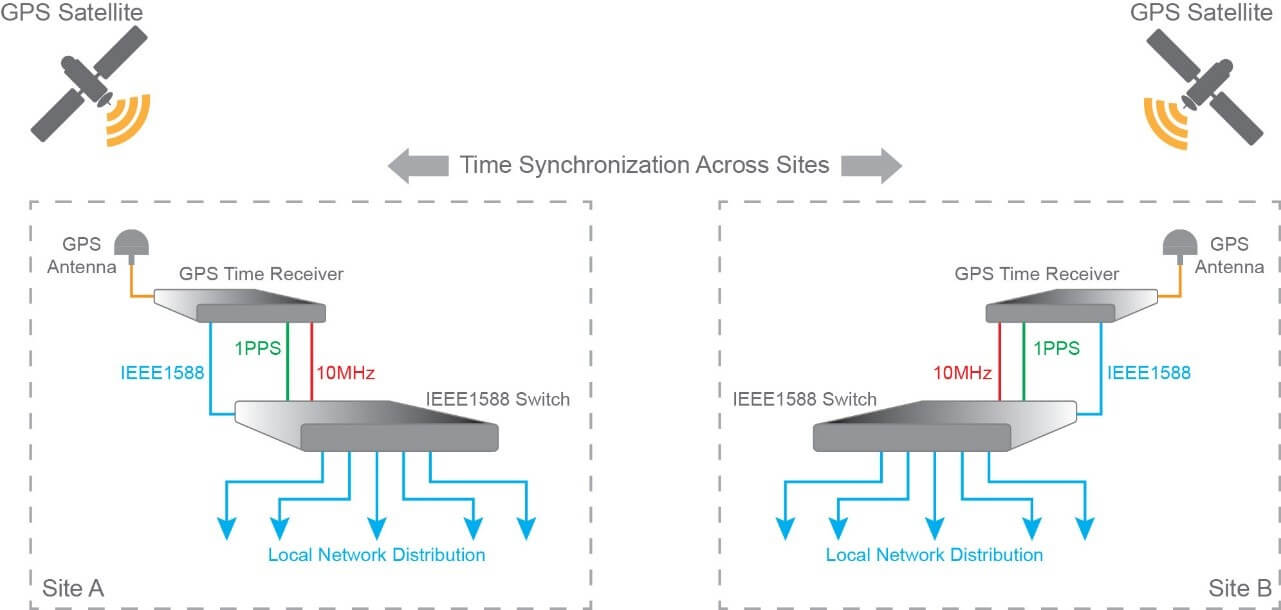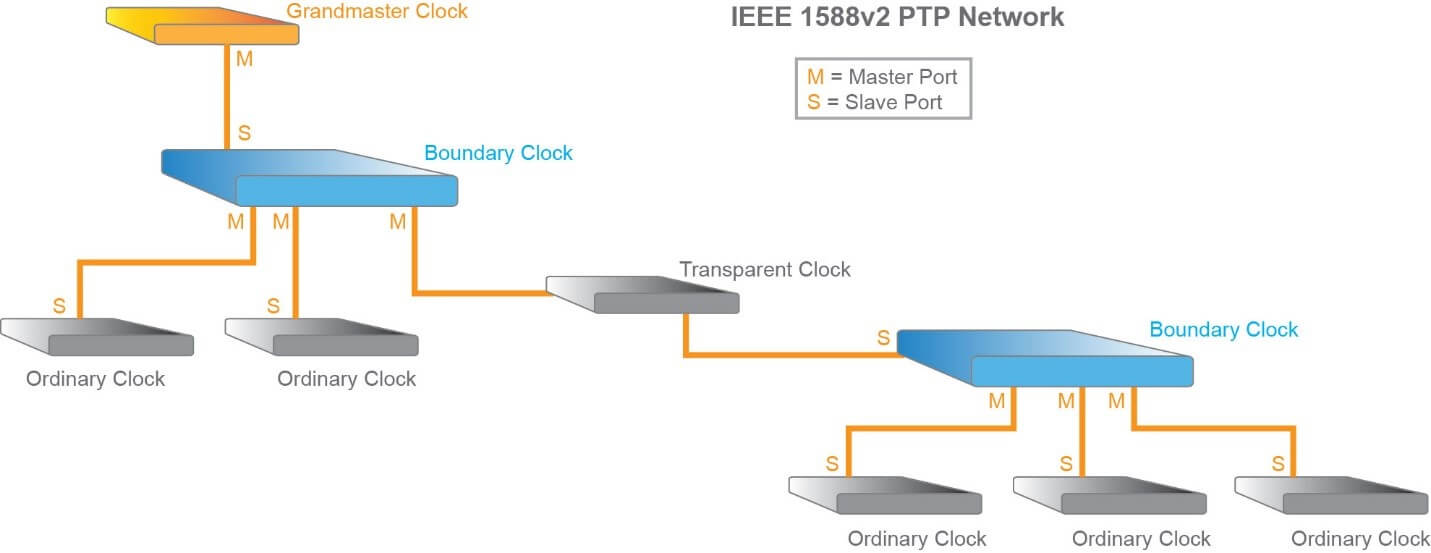Network Time Synchronization
How Important is Accurate Time Synchronization?
Providing clock synchronization or simple timing signals has been important for many applications stretching back decades. Although many time synchronization methods and standards have been employed over the years, they have mostly been limited by accuracy or distance. That is, time synchronization between devices over very short distances can easily achieve a high level of accuracy, but at longer distances maintaining the required accuracy has proved difficult.
In today’s network-connected world, precise clock synchronization has become essential for many applications and services. Fortunately, through the use of global satellite time and new network time protocols, network devices can now maintain synchronized time down to the sub-microsecond level. This Technology Brief provides an overview of network time synchronization and how precision timing can now be achieved over almost any distance and at any location worldwide.
Time Synchronization and Network Distribution
Time of day, frequency, and phase are all-important elements in synchronizing time. Time is measured by clocks, which can simply be defined as a device with a stable source frequency and a counter. Frequency is the measure of a repeating event within a period of time, normally stated in Hertz or the number of events in a second. Phase synchronization is when two separate repeating events happen at the same point in time. Accurate time synchronization in any application therefore involves the distribution of the time of day, frequency, and phase between devices.
All network devices contain components that count time, typically based on crystal oscillators that output an electrical signal with a precise frequency. When synchronized time between devices is important, clocks can therefore track the time with good accuracy. However, when precise time synchronization is required, it is found that even identical devices still lose synchronization over time. This reality is due to slight physical differences between crystal oscillators and temperature variations that affect the exact output frequency and therefore the clock time. To maintain accurate time between network devices requires continuous synchronization from a reference time source that has a more accurate, reliable clock.
The need for time synchronization in radio broadcasts, telecommunications, and test and measurement applications has a long history. Time of day codes, frequency and phase signals in various formats can be found integrated into all kinds of equipment. The following table lists some of the more common timing signals and standards that are in use, as well as current network time protocols.
| Name | Description |
|---|---|
| 1PPS (1 Pulse per Second) | An electrical pulse signal aligned to the start of each second. Accurate to 12 picoseconds to a few microseconds per second depending on the generating source. |
| 10 MHz | A precise reference frequency signal used for synchronization. |
| TOD (Time of Day) | An interface that combines an RS-422 serial connection with a 1PPS signal. |
| BITS (Building-Integrated Timing Supply) | A system that distributes timing signals within a building over T1/E1 connections. |
| NTP (Network Time Protocol) | Standard protocol for the distribution of network time. Accurate to within tens of milliseconds. |
| IEEE 1588 (Precision Time Protocol) | Precision time synchronization over networks. Accuracy ranges from 10 ns to 100 ns. |
| GPS (Global Positioning System) | High-precision time synchronization from global satellites. Accuracy of about 100 nanoseconds. |
The time synchronization method used depends mostly on the distance between the equipment that requires synchronization. A connection distance not only involves delay, but also degradation of the signal quality. Therefore, the physical signal connections of 1PPS, 10 MHz, and TOD, are limited to equipment connections in the same rack or room. BITS signals are used for connections within the same building. Both NTP and IEEE 1588 are protocols that provide time synchronization over Ethernet networks, which can span a whole range of distances. For much larger distances, GPS time has become the standard for providing precise synchronization between distant locations. Typically, a GPS device serves as a reference master clock at a location and provides time synchronization signals to other equipment and the local network.

The Precision Time Protocol – IEEE 1588
For many years, the Network Time Protocol (NTP) has been the standard method for time synchronization across networks and is still widely used today. Although NTP is capable of millisecond accuracy, this was not accurate enough for some applications and in 2002 a more accurate network synchronization standard was released, called IEEE 1588 or the Precision Time Protocol (PTP). In 2008, the PTP protocol was revised to be even more accurate, often referred to as IEEE 1588v2 or PTPv2, providing a potential accuracy down to the nanosecond level. The PTP synchronization described in this Technology Brief refers to the IEEE 1588v2 protocol.
The current PTP protocol provides fault-tolerant synchronization among clocks embedded in devices across a network. PTP uses what is called the Best Master Clock algorithm to determine the most accurate clock in a network, and then synchronizes all other clocks to the “grandmaster” clock. The grandmaster clock sends “sync” packets with embedded timestamps to “slave” clocks across the network. By accurately measuring the network delays between the grandmaster and slave clocks, precise offsets are determined to keep the slave clocks in synchronization with the grandmaster. If a grandmaster clock is no longer available on the network, the Best Master Clock algorithm defines which is the new grandmaster clock and adjusts other clocks accordingly.
Network switches and other devices that include IEEE 1588v2 support have the ability at the hardware level to timestamp packets as they ingress and egress network ports. To prevent uncertain delays within a switch from causing inaccuracies in the time synchronization, the timestamps are added to packets between the MAC and PHY layer, exactly when a packet enters or leaves a port. For devices where there is a delay between the software sending a packet and it leaving a port, the extra delay time is sent in a follow-up packet. Once all network delays have been determined from the packet timestamps, a slave clock time can be precisely adjusted to the grandmaster clock time.
For networks that have a larger PTP domain with many switches and connected devices, the IEEE 1588v2 protocol also defines a hierarchy of clock types that help ensure accurate time synchronization across the network.
- Ordinary Clock: A clock device that has a single port connection to the network. This clock type can function as grandmaster or slave in the PTP domain.
- Boundary Clock: A clock that provides multiple connections to the network. One slave port will synchronize time with an upstream PTP clock, and other ports may serve as master ports to other downstream slave clocks. The connected slave clocks synchronize time directly with the boundary clock rather than the PTP domain grandmaster clock.
- Transparent Clock: A network device that does not synchronize its time but processes PTP messages and corrects for forwarding delays through the device.
Using the clock type hierarchy in a PTP network essentially removes or compensates for jitter effects and internal delays created in Ethernet switches and maintains time synchronization precision to at least the sub-microsecond level.

Time Synchronization to the Sub-Microsecond Level
Although time synchronization has been important for many years in a multitude of applications, the growing challenges and requirements of telecommunications and networking have given rise to impressive levels of accuracy, even over vast global distances. With GPS global satellite time being synchronized to atomic clock time, it provides an extremely precise time at any location where a GPS receiver can use a combination of 1PPS and 10MHz signals along with a PTP-capable network to synchronize any number of devices down to sub-microsecond accuracy.

